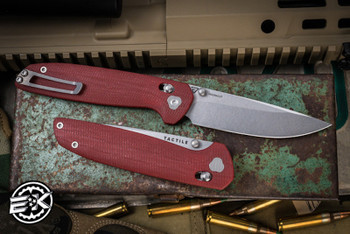EDC for Beginners: How to Properly Carry Your Folding Knife
May 15th 2018
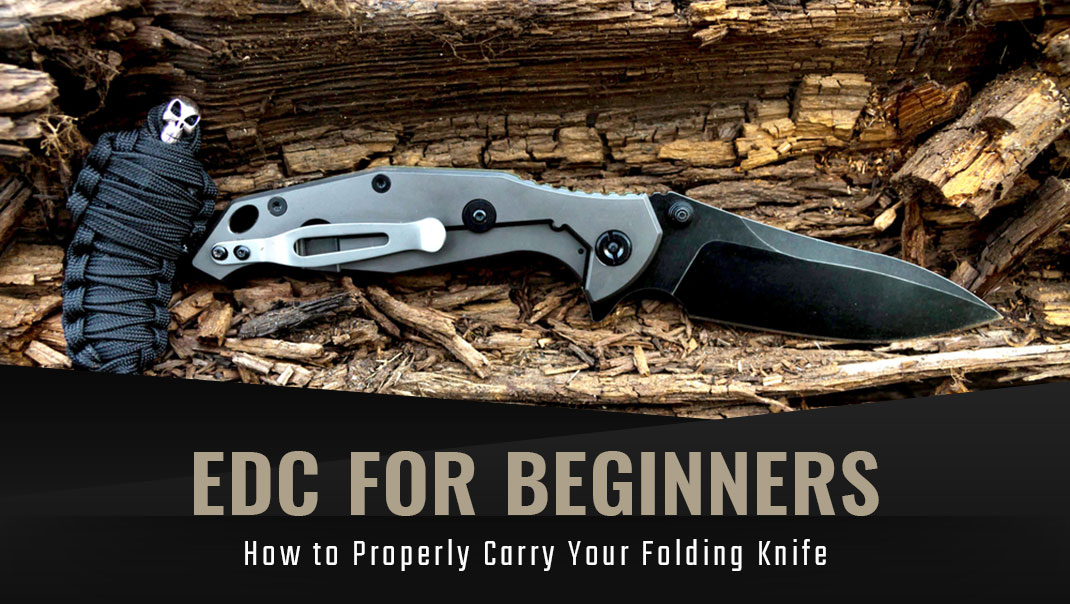
EDC stands for "Everyday Carry": this includes all of the items you choose to carry with you in your day-to-day life. This can mean a variety of items such as your wallet, phone, car and house keys, lip gloss, lotion and yes, even your folding knife.
Many people already carry some sort of folding knife for utility purposes such as opening boxes and other items, fishing, hiking and other activities. Some of these knives (such as a Swiss Army knife) are multi-tool and contain scissors, can openers, screwdrivers and tweezers in addition to the blade.
Check Out Our Collection of Custom Folding Knives
The reasons for having an EDC knife differ with each person, but understanding how to carry the knife properly and safely is an important aspect to consider when you purchase a folding knife.
What is EDC?
While some people choose an EDC for utility reasons, others choose EDC knives for their hobbies, such as camping or model building. Still, other people decide on an EDC knife for an added level of personal protection, especially if they leave work late at night or have to transport money to a bank.
There are many advantages to adding an EDC knife to your EDC items, and there are several styles of folding knives that will meet your expectations and needs. With a little bit of research, adding an EDC knife to your EDC stash is easy.
Folding Knife Anatomy
The basic folding knife has nine basic pieces of anatomy, although this can differ according to the style and design of the knife. These pieces include:
- Point: the end of the blade, usually sharp and used for piercing.
- Blade: the slicing part of the blade, usually angled.
- Spine: the top of the blade, usually dull.
- Ricasso: the unsharpened portion of the blade, usually right before the handle.
- Pivot: the place where the knife meets the handle, and the mechanism for how it folds and unfolds.
- Thumb stud: found on modern knife patterns, this is the metal stud that the thumb uses to unfold the blade from the handle.
- Lock bar: the type of lock on a folding knife differs according to the knife design, but this is generally the bar that secures the blade to keep it from closing once it is open and usually has to be manually depressed in order to close the blade.
- Handle: this is the grip that the wearer uses when holding the knife.
- Lanyard hole/pocket clip: this is an area on the knife that is used to carry it either on a neck lanyard or in a pocket or on a belt. It is usually located at the very end of the handle.
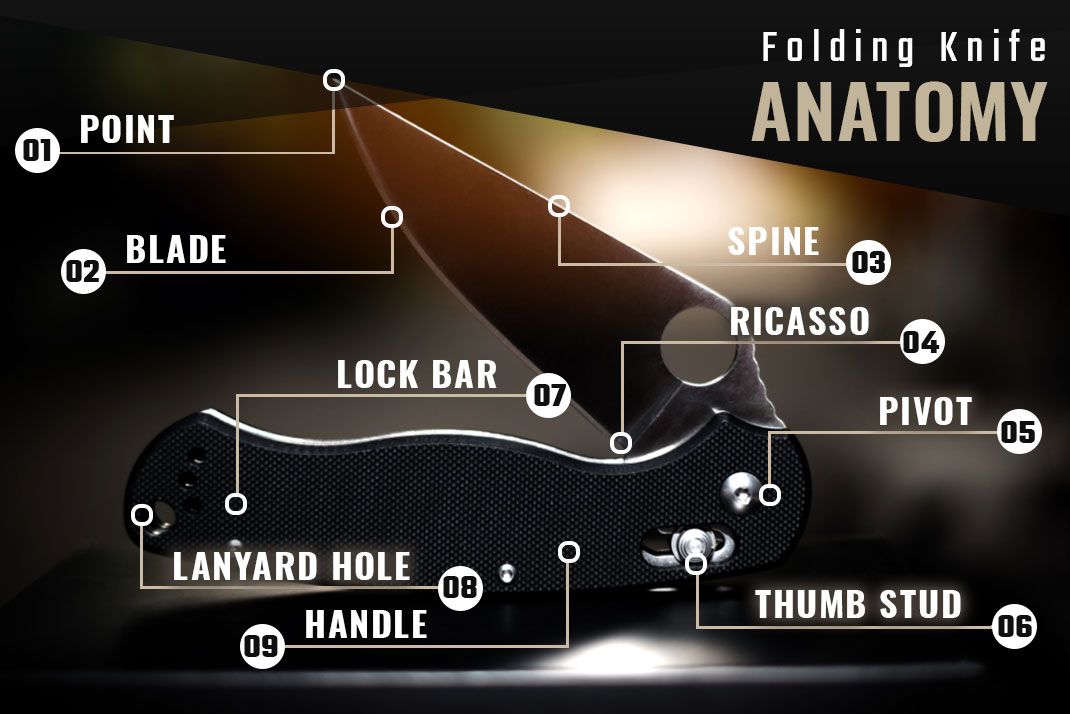
Laws and Regulations
Before we delve into the nitty-gritty about the different styles and types of EDC knives you may wish to purchase, you must first familiarize yourself with local knife-carrying laws in your state or jurisdiction.
Browse Our Assortment of Microtech Knives to Find the Right One for You
.ctaBtn {background:#000;color:#fff;display:table;margin:0 auto;padding:20px;font-weight:700;border:1px solid #000;text-align:center;text-decoration:none;}.ctaBtn:hover {background:#fff;color:#000;}
Some areas have restrictions on knife blade lengths, where knives can be carried at all and whether a knife can be carried unconcealed. Other areas have restrictions on specific styles of knives that can be carried, such as Bowie knives, Basilongs and even butcher knives. Many areas have restrictions on switchblades.
Also keep in mind that some areas restrict knife carry by age, meaning minors may be restricted from carrying. Schools are typically off-limits for any sort of carry, and violations of these laws are felonies, not misdemeanors. There are exceptions made in some states for minor carry for hunting and fishing purposes.
Unfortunately, many states and jurisdictions ban "types" or "styles" without clearly defining what that may be, and this ambiguity can lead to disputes and false arrests. The best resource, of course, is to contact your local law enforcement agency and discuss what they consider to be legal or illegal EDC knives and request the accompanying statutes for their reasoning.
Styles of Folding Knives
There are two styles of folding knives: modern and traditional. Traditional folding knives were developed for specific trades and tasks, but modern folding knives have evolved to meet the needs of any profession or task.
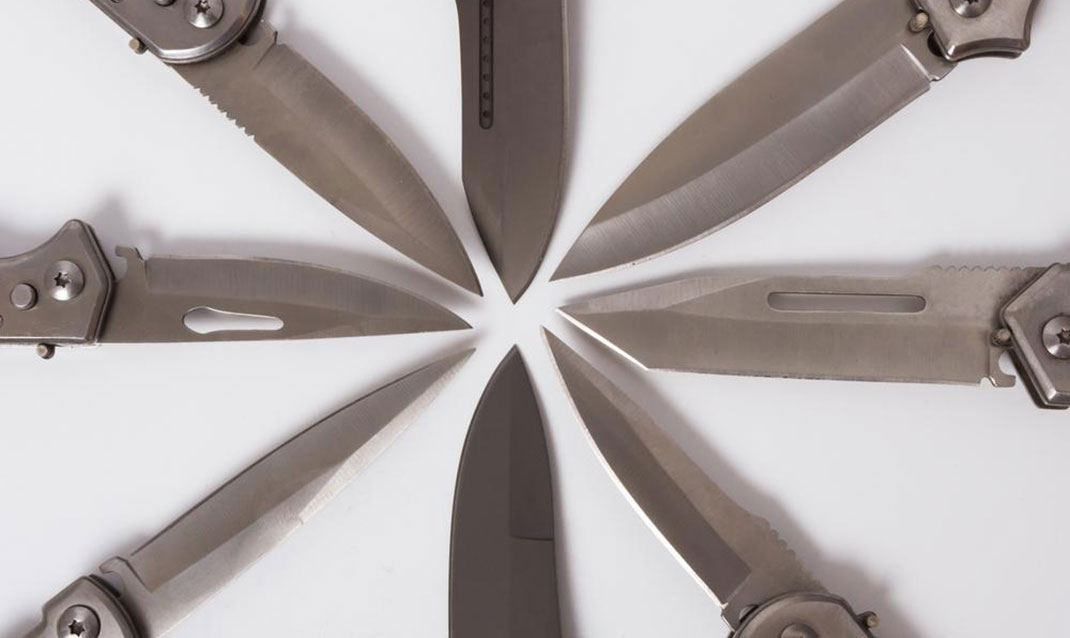
Traditional folding knives are more difficult to open quickly, and often require two hands. Modern folding knife patterns have the advantages of a one-handed open with a thumb stud and one-handed closing with a blade lock. They are also easier to clean and easier to disassemble than traditional folding knife patterns. The modern folding knives are geared more towards tactical use in general which makes them better for self-defense. Microtech knives work great for self-defense purposes.
The pros for traditional folding knives include the carbon steel knife blade which stands up to the test of time and wear and tear. No matter how many years pass and how many times the blade gets used, these knives can always be depended on to work; they rarely fail the user.
Blade Design
Modern and traditional knives each have unique and distinct blade designs you will want to consider before choosing your EDC folding knife. Depending on your needs and expectations for this carry knife, the following blade designs will deliver different results.
Spear Point
The spear point blade's tip aligns with the center of the blade. This blade is most commonly seen on throwing knives because they pierce objects very easily and steadily. While it is an excellent choice for piercing or stabbing through things, it is not necessarily as adept for cutting or slicing items.
Clip Point
The clip point blade features the tip of the blade looking as if it has been "clipped off." This blade features a sharp tip which makes it excellent for piercing and stabbing, much like the spear point. However, because of the thinness of the blade's tip, it is more easily broken than other blade designs.
Drop Point
The drop point blade is one of the most familiar-looking blades on a folding knife. It is convex-shaped with a sloped spine from the handle and lowered point, making it an excellent choice for a general-purpose knife. These knives are utilized for cutting but not so much for piercing or stabbing. Most hunting knives are equipped with drop points, and they are especially durable for hunting use.
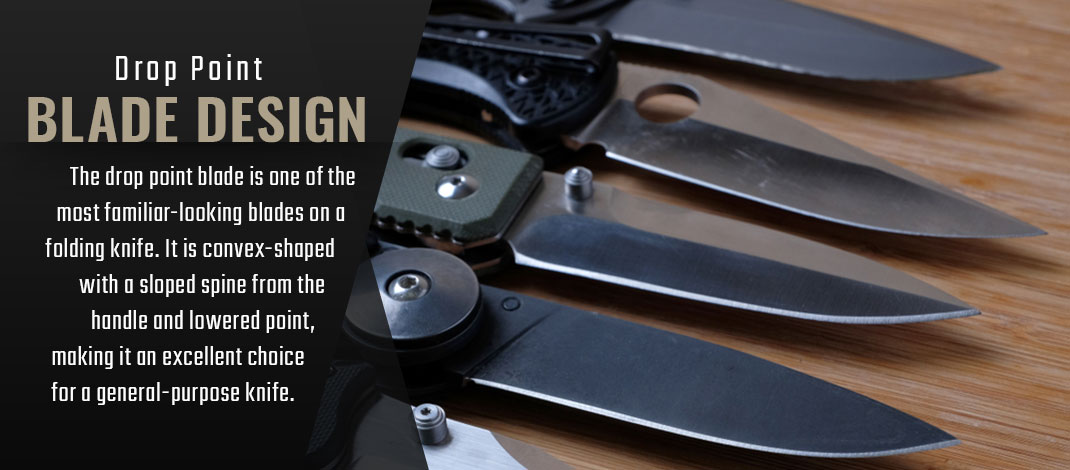
Sheepsfoot/Wharncliffe
The Sheepsfoot/Wharncliffe blade is a straight-edged, slightly-curved blade with a dull spine. It is excellent for cutting and general-purpose use and safer than a drop point or clip point design. For this reason, it is favored for use by first responders in rescue situations, such as EMTs who quickly need to remove a seatbelt or an article of clothing. The lowered risk of accidentally stabbing yourself or the person you are assisting makes this an excellent choice for situations like these.
Serrated Blades
Serrated blade knives are used for specific purposes, such as slicing through ropes or wood. They work more like a saw than a knife and may be advantageous for situations where a more forceful cut is required. It's probably not the most useful blade for general-purpose use, but for those who find themselves needing to saw through tough, textured materials, the serrated knife blade design might be the best option.
Handle Designs
Of course, when you are holding your knife, you want to make sure it fits comfortably into the palm of your hand. It should be a handle you can easily control and should be textured for added grip. Some people also prefer contoured finger holds for added grip. Traditional knives and modern knives differ in the handle designs they offer.
The best thing you can do to find which handle design works best for your hands is to hold a few knives. Longer hands need longer handles; thick hands need smaller diameters. If you will be utilizing your knife primarily at work with gloves, this will also change how the knife fits into your hand. You need to find out which knife you can grip properly and with enough dexterity to accomplish your everyday tasks.
Handles come in a variety of materials as well which will also affect the grip and comfort of the knife in your palm. There are several synthetic materials, such as micarta, fiberglass and hard nylon, that are options for some of the more modern knife patterns. You can also choose from natural materials, such as hardwood, bone, leather and Mother of Pearl. Then, there are designs in titanium, stainless steel, high-carbon steel and aluminum. Depending on the material and textured design, you will need the design that works best for your hands and your needs.
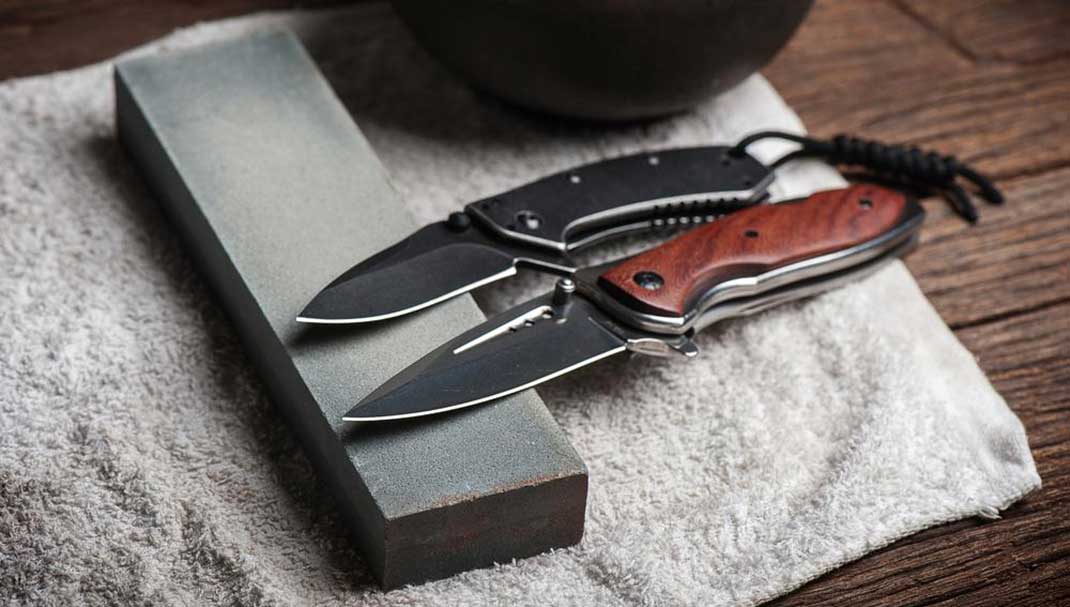
Blade Steels
There are two types of steels used in knife blades: stainless steel and high-carbon, non-stainless steel. The measure of hardiness of the blade is measured on a scale called the Rockwell Hardness scale. Depending on the manufacturing company, traditional knife patterns tend to make use of the non-stainless high-carbon steel blades which are generally tougher and longer lasting but more prone to corrosion. Some professionals actually conduct scratch tests to determine the corrosion and wear of stainless steel.
Modern folding knife patterns utilize the stainless-steel blade design which is less prone to corrosion but not as hardy as traditional knife patterns. If a blade is going to break, it will be a stainless-steel blade. They are also more difficult to sharpen than the high-carbon blades.
Weight
Another aspect to consider is the weight of your EDC folding knife. If you are looking for a lighter carry, keep in mind that the materials used to manufacture lighter knives, such as aluminum, may not always have the best durability. However, sometimes it is not practical to carry a knife that weighs a lot for 10-16 hours a day. It's important to find a balance between usability, durability and carry ability.
Custom folding knives
As with all fun tools, you can also take a look at some of the options offered with custom knives. Many of these custom folding knives offer different features, such as Tanto-style and Borka blades, stylized handles and special finishes, which may meet your daily needs just as well as traditional and modern folding knives.
How to Properly Carry Your Folding Knife
After you have familiarized yourself with the laws and regulations in your city or jurisdiction, you can decide if your EDC knife is one you want to carry concealed or unconcealed.
Most modern knife patterns have a pocket clip which you can use to place your knife on the inside or outside of your pocket or belt. Ladies, you can also use this clip to secure the knife on a specific pocket of your purse for ease-of-access.

There are also carry holsters which can secure and protect your knife, especially if you are in an environment with a lot of dirt or moisture. Holsters protect your blade from the elements which lessens the need for frequent cleanings. These holsters typically come with a pocket clip of some kind so they can also be worn outside or inside a pocket or belt. The downside is that releasing them from their holster might take a few extra seconds which will slow you down a bit.
If you are utilizing the EDC knife for self-defense, you want it to be a knife you can speedily grab and operate, and it should not snag on anything in the process.
For some people, this may mean adjusting what you keep in your pockets. If you carry your wallet and phone in your back pockets, make sure your knife is accessible from your belt or front pocket.
Ideally, your keys should also not be kept in the same pocket or area as your knife, as they can get caught up in each other when you are pulling the knife or keys out.
If you are utilizing a blade with a sharp point, such as a drop point blade, spend time building muscle memory of pulling out and opening the knife. In an emergency or tense situation, you don't want to slice or stab yourself while opening the knife accidentally.
EDC Folding Knife Spotlight
Zero Tolerance 0462
Designed by Dimitry Sinkevish, the 0462 is an unyielding EDC knife with a 3.75-inch CPM, 20 CV steel blade and a stonewashed and satin finish. This made-in-the-U.S. product has a blade thickness of 0.156 inches, weighs 3.7 oz and has an overall length of 8.9 inches.

The beautifully detailed and curved handle is made from a red carbon fiber front and stonewashed titanium back.
The 0462, like other ZTs, opens quickly due to its assisted KVT-ball bearing system. This rugged and wear-resistant knife is easy to clean and re-sharpen.
Final Thoughts
Adding an EDC folding knife to your daily carry items is a useful tool for completing everyday tasks and giving you an added layer of self-defense. Spend time researching and holding folding knives to get a sense of which will be the best style of knife to fit your needs, and you will likely find your EDC knife to be something you soon can't leave home without.

